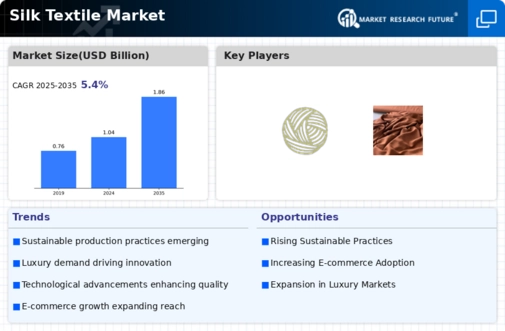Market Trends and Projections
The Global Silk Textile Market Industry is characterized by various trends and projections that indicate its future trajectory. The market is expected to grow from 1.04 USD Billion in 2024 to 1.86 USD Billion by 2035, reflecting a strong upward trend. The compound annual growth rate of 5.43% from 2025 to 2035 suggests a steady increase in demand, driven by factors such as luxury consumption, sustainability, and technological advancements. These trends highlight the dynamic nature of the silk textile market and its potential for expansion in the coming years.
Growing Demand for Luxury Textiles
The Global Silk Textile Market Industry is experiencing a notable increase in demand for luxury textiles, driven by rising disposable incomes and changing consumer preferences. As consumers increasingly seek high-quality, sustainable fabrics, silk has emerged as a preferred choice due to its luxurious feel and aesthetic appeal. This trend is particularly evident in regions such as Asia-Pacific and North America, where the market is projected to reach 1.04 USD Billion in 2024. The growing inclination towards premium products suggests that the silk textile sector will continue to thrive, potentially leading to a market value of 1.86 USD Billion by 2035.
Sustainability and Eco-Friendly Practices
Sustainability has become a pivotal driver in the Global Silk Textile Market Industry, as consumers and manufacturers alike prioritize eco-friendly practices. The silk production process, which is often perceived as more sustainable compared to synthetic alternatives, aligns with the increasing demand for environmentally responsible textiles. This shift towards sustainability is likely to enhance the market's appeal, as brands adopt transparent supply chains and ethical sourcing methods. Consequently, the market may witness a compound annual growth rate of 5.43% from 2025 to 2035, reflecting the growing importance of sustainable practices in the textile industry.
Emerging Markets and Global Trade Dynamics
Emerging markets are playing a crucial role in shaping the Global Silk Textile Market Industry. Countries in Asia, particularly China and India, are not only leading producers but also significant consumers of silk textiles. The expansion of these markets is supported by increasing urbanization and a burgeoning middle class, which drives demand for silk products. Furthermore, global trade dynamics are facilitating the export of silk textiles to developed regions, enhancing market accessibility. This interconnectedness suggests a robust growth potential, with projections indicating a compound annual growth rate of 5.43% from 2025 to 2035.
Technological Advancements in Silk Production
Technological innovations in silk production are significantly influencing the Global Silk Textile Market Industry. Advances in sericulture techniques and processing technologies have improved the efficiency and quality of silk production. For instance, the introduction of automated reeling machines and biotechnology in silk farming has enhanced yield rates and reduced production costs. These developments not only cater to the increasing global demand for silk but also position the industry for sustainable growth. As a result, the market is expected to expand, with projections indicating a rise to 1.86 USD Billion by 2035, driven by these technological enhancements.
Rising Popularity of Silk in Fashion and Home Decor
The Global Silk Textile Market Industry is witnessing a surge in the popularity of silk in both fashion and home decor sectors. Designers and consumers are increasingly incorporating silk into clothing, accessories, and interior furnishings, recognizing its versatility and luxurious qualities. This trend is particularly pronounced in high-end fashion markets, where silk garments are often associated with elegance and sophistication. The growing use of silk in home textiles, such as curtains and upholstery, further underscores its appeal. This multifaceted demand is likely to contribute to the market's growth trajectory, with an anticipated value of 1.04 USD Billion in 2024.













